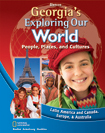

Exploring Our World: Latin America and Canada, Europe, and Australia © 2012 Georgia EditionChapter 12: Australia TodayChapter OverviewsCompared to other world regions, Australia is sparsely populated and unevenly settled. Most of its 20.6 million people live in a few urban centers along the coasts. These well-populated coastal areas have a mild climate, fertile soil, and access to the ocean. Only a small number of Australians live in the vast, dry, and remote interior. Most people in Australia are of European descent. English is the country's official language, and Christianity is its largest religion. However, the number of people of Asian and Aboriginal backgrounds has grown in recent years. As a result, Australia's ethnic and religious communities have become increasingly varied. For years, Aborigines faced discrimination from white Australians. Conditions have improved for the Aborigines since the 1960s, but many Aborigines still have a lower literacy rate, work in low-paying jobs, and suffer from poverty and poor health care. In recent years, the Aborigines have pushed more forcefully for their rights. For example, Aboriginal groups have turned to the courts and won control of land once belonging to their people. Land claims by Aborigines, however, have raised tensions with other Australian landowners. The culture of Australia draws from European, Aboriginal, and Asian sources. European influences have had the strongest impact since the 1800s. For example, Australians enjoy a variety of outdoor sports, many of which came from Europe. The culture of the Aborigines goes back thousands of years and is enjoying a modern revival. Aboriginal music, dance, and rock and bark paintings tell about the relationship of humans to nature. The land has also been a major theme in the arts created by Australians of European descent. Australia has a prosperous mixed economy. For many years, the cattle and sheep industries were dominant. Since World War II, manufacturing, services, and tourism have grown enormously. Australia exports many minerals, including coal, iron ore, bauxite, gold, and gems. In recent years, Asian countries have become Australia's chief trading partners. The growth of Australia's economy has brought challenges. Mining and ranching have caused some damage to the environment. Animals introduced from other lands are sometimes harmful to native animals. Australians are taking steps to protect the environment. Concerned about climate change, they have established goals for cutting the amount of fossil fuels burned in Australia. |  |















